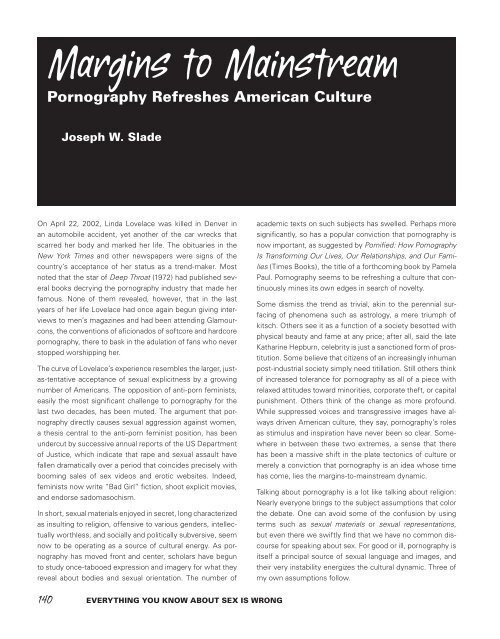You also want an ePaper? Increase the reach of your titles
YUMPU automatically turns print PDFs into web optimized ePapers that Google loves.
Margins to Mainstream<br />
Pornography Refreshes American Culture<br />
Joseph W. Slade<br />
On April 22, 2002, Linda Lovelace was killed in Denver in<br />
an automobile accident, yet another of the car wrecks that<br />
scarred her body and marked her life. The obituaries in the<br />
New York Times and other newspapers were signs of the<br />
country’s acceptance of her status as a trend-maker. Most<br />
noted that the star of Deep Throat (1972) had published several<br />
books decrying the pornography industry that made her<br />
famous. None of them revealed, however, that in the last<br />
years of her life Lovelace had once again begun giving interviews<br />
to men’s magazines and had been attending Glamourcons,<br />
the conventions of aficionados of softcore and hardcore<br />
pornography, there to bask in the adulation of fans who never<br />
stopped worshipping her.<br />
The curve of Lovelace’s experience resembles the larger, justas-tentative<br />
acceptance of sexual explicitness by a growing<br />
number of Americans. The opposition of anti-porn feminists,<br />
easily the most significant challenge to pornography for the<br />
last two decades, has been muted. The argument that pornography<br />
directly causes sexual aggression against women,<br />
a thesis central to the anti-porn feminist position, has been<br />
undercut by successive annual reports of the US Department<br />
of Justice, which indicate that rape and sexual assault have<br />
fallen dramatically over a period that coincides precisely with<br />
booming sales of sex videos and erotic websites. Indeed,<br />
feminists now write “Bad Girl” fiction, shoot explicit movies,<br />
and endorse sadomasochism.<br />
In short, sexual materials enjoyed in secret, long characterized<br />
as insulting to religion, offensive to various genders, intellectually<br />
worthless, and socially and politically subversive, seem<br />
now to be operating as a source of cultural energy. As pornography<br />
has moved front and center, scholars have begun<br />
to study once-tabooed expression and imagery for what they<br />
reveal about bodies and sexual orientation. The number of<br />
academic texts on such subjects has swelled. Perhaps more<br />
significantly, so has a popular conviction that pornography is<br />
now important, as suggested by Pornified: How Pornography<br />
Is Transforming Our Lives, Our Relationships, and Our Families<br />
(Times Books), the title of a forthcoming book by Pamela<br />
Paul. Pornography seems to be refreshing a culture that continuously<br />
mines its own edges in search of novelty.<br />
Some dismiss the trend as trivial, akin to the perennial surfacing<br />
of phenomena such as astrology, a mere triumph of<br />
kitsch. Others see it as a function of a society besotted with<br />
physical beauty and fame at any price; after all, said the late<br />
Katharine Hepburn, celebrity is just a sanctioned form of prostitution.<br />
Some believe that citizens of an increasingly inhuman<br />
post-industrial society simply need titillation. Still others think<br />
of increased tolerance for pornography as all of a piece with<br />
relaxed attitudes toward minorities, corporate theft, or capital<br />
punishment. Others think of the change as more profound.<br />
While suppressed voices and transgressive images have always<br />
driven American culture, they say, pornography’s roles<br />
as stimulus and inspiration have never been so clear. Somewhere<br />
in between these two extremes, a sense that there<br />
has been a massive shift in the plate tectonics of culture or<br />
merely a conviction that pornography is an idea whose time<br />
has come, lies the margins-to-mainstream dynamic.<br />
Talking about pornography is a lot like talking about religion:<br />
Nearly everyone brings to the subject assumptions that color<br />
the debate. One can avoid some of the confusion by using<br />
terms such as sexual materials or sexual representations,<br />
but even there we swiftly find that we have no common discourse<br />
for speaking about sex. For good or ill, pornography is<br />
itself a principal source of sexual language and images, and<br />
their very instability energizes the cultural dynamic. Three of<br />
my own assumptions follow.<br />
140 EVERYTHING YOU KNOW ABOUT SEX IS <strong>WRONG</strong>


